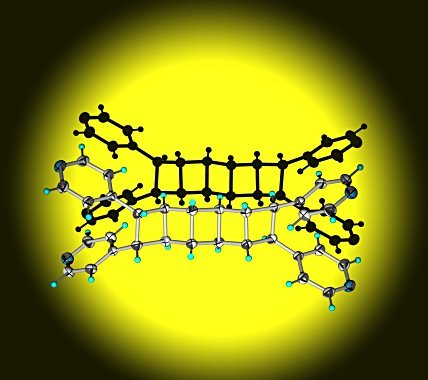T
Molecular step ladders with four and six rungs have been constructed by US researchers. These tiny units could be used as novel building blocks for optoelectronic components and nanoscale applications.
Leonard MacGillivray and his team at the University of Iowa have built ladderanes by essentially clipping together three or four five square-shaped molecules known as cyclobutanes. The actual synthesis involves building the ladders from two individual beams formed from carbon chains. By irradiating the starting materials with ultraviolet light the chemists can induce the two beams to react with each other – in theory, at least. The UV energy is sufficient to cause all the double bonds to swing open and the released arms to reach out and grab the carbon atoms of an adjacent beam. These new alternating single and double carbon bonds form the rungs of the ladder.

Leonard MacGillivray
That’s the theory. In practice, this approach failed in the laboratory because the carbon chains cannot be brought close enough together nor held in a suitable position for the reaction to take place. One way to surmount the problem of ladderane assembly is to carry out the reaction in the solid phase rather than in free-floating solution. The solid reaction also by necessity requires the beams to be fixed pairwise and strictly in parallel for reaction to take place but, according to MacGillivray, this can be achieved by attaching a pyridine molecule – a six-membered ring molecule consisting of one nitrogen and five carbon atoms – to the ends of each beam. The pyridines can then be used as anchor points on the carbon chains on to which a six-membered carbon ring – resorcinol, which has two hydroxy (OH) groups, can be hooked. When this mixture is crystallized the result is paired up and parallel carbon chains.
The OH groups form a bridging hydrogen bond with the nitrogen atoms on the pyridine molecules so each carbon chain is clamped together in pairs at each end by a resorcinol molecule. The two beams thus lie perfectly in parallel within the crystal.

Climbing to the top (Credit: Leonard MacGillivray)
The researchers found that when they now irradiate the crystals with UV light, the opposing double bonds convert into the desired ladder rungs. Neighbouring pairs of beams are offset within the crystal, such that they cannot form rungs with each other. In the final step, the ladders can be released from the resorcinol crystal structure by adding an organic solvent, dichloromethane. The critical covalent-bonding-making process is solvent-free, explains MacGillivray, and therefore green; we are also working toward a method wherein we grind together solid resorcinol and bipyridine and separate using water. Such an approach would be environmentally greener still.
The result are molecular scale ladders known as [3]- and [5]-ladderanes, which essentially consist of three or five cyclobutane units and so have four and six rungs, respectively. The team is now working on building longer ladders. We are currently at the [5]-ladderane and are viewing the [7]-ladderane, MacGillivray revealed to us. We are also planning to remove the pyridines to leave behind the pure hydrocarbon.
The ladders could be used as rigid and highly tuneable bridges – with each step increasing the length of the bridge – to determine how atoms and molecules communicate electronically, MacGillivray told Spotlight. The longer ladders may provide fundamental insights into communication at the nanometre scale.
Further reading
Angew. Chem. Int. Ed. 2004, 43, 232-236
http://dx.DOI.org/10.1002/anie.200352713
Leonard MacGillivray
http://www.chem.uiowa.edu/faculty/macgillivray/